

10 Tips. By Dr.
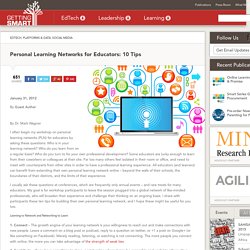
Mark Wagner. 16 Ways Educators Can Use Pinterest [INFOGRAPHIC] Teachers are known for their organizational skills, so chances are they'll love Pinterest's intuitive and logical design. The social network's user experience has helped it earn a top spot among today's most popular social networks. Therefore, we predict that teachers will give it a gold star, too. Our friends at OnlineUniversities.com have put together the following infographic, which details how teachers can use Pinterest to organize lesson plans, distribute curricula, collaborate with other faculty, and even encourage student participation. SEE ALSO: 9 Ways to Engage Your Employees on Pinterest Remember, however, that Pinterest's terms of service dictate that users under the age of 13 are prohibited. Powered by Solution Tree.
Professional learning community (PLC) An ongoing process in which educators work collaboratively in recurring cycles of collective inquiry and action research to achieve better results for the students they serve.
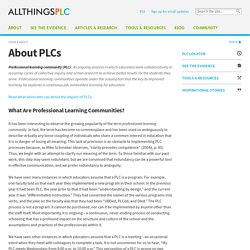
Professional learning communities operate under the assumption that the key to improved learning for students is continuous job-embedded learning for educators. Read what advocates say about the impact of PLCs. What Are Professional Learning Communities? It has been interesting to observe the growing popularity of the term professional learning community. We have seen many instances in which educators assume that a PLC is a program. Educational Leadership:Schools as Learning Communities:What Is a Professional Learning Community? How Do I Get a PLN? What is a PLN?
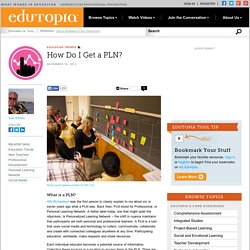
Will Richardson was the first person to clearly explain to me about six or seven years ago what a PLN was. Back then, PLN stood for Professional, or Personal Learning Network. A better label today, one that might quiet the nitpickers, is Personalized Learning Network -- the shift in nuance maintains that participants are both personal and professional learners. A PLN is a tool that uses social media and technology to collect, communicate, collaborate and create with connected colleagues anywhere at any time. Participating educators, worldwide, make requests and share resources.
Each individual educator becomes a potential source of information. PLNs Develop Thought Leaders Many early adopters of the PLN have gone on to become thought leaders in education, not surprising given that PLNs seem to promote a great deal of reflection and collaboration. Barriers to Mass Adoption We must remember that lifelong learning requires effort. Introduction - Issues ...about Change, Professional Learning Communities: What Are They And Why Are They Important?, Volume 6, Number 1.
Home | Issues ...about Change Archive | Professional Learning Communities: What Are They And Why Are They Important?
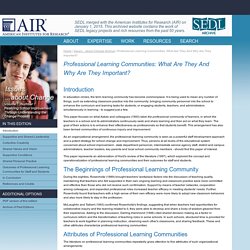
In education circles, the term learning community has become commonplace. It is being used to mean any number of things, such as extending classroom practice into the community; bringing community personnel into the school to enhance the curriculum and learning tasks for students; or engaging students, teachers, and administrators simultaneously in learning - to suggest just a few. This paper focuses on what Astuto and colleagues (1993) label the professional community of learners, in which the teachers in a school and its administrators continuously seek and share learning and then act on what they learn. The goal of their actions is to enhance their effectiveness as professionals so that students benefit. This arrangement has also been termed communities of continuous inquiry and improvement. Each of these is discussed briefly in this paper.
Knowledge Sharing. Personal Learning Networks. Pinterest- PLN. Put the Personal in Your PLN. The term personal learning network (PLN) has been a part of technology junkies' vocabulary for more than 10 years,1 but the tools and skills needed to take full advantage of networked learning continue to evolve.

I define a PLN as a self-created set of experts, colleagues, and resources—usually dependent on networked technology—that meet one's daily learning needs. I got my first taste of a PLN in the early 1990s when LM_Net—an e-mail list of school librarians around the United States, and later around the world—got started. This peer network provided librarians with a venue for sharing resources, asking questions, venting, and trumpeting successes online. Because our field was being transformed dramatically by technology, LM_Net filled an urgent need. Utilizing Twitter chats for professional development SmartBlogs. Each week, educators from around the world take part in various conversations on Twitter known as “chats.”
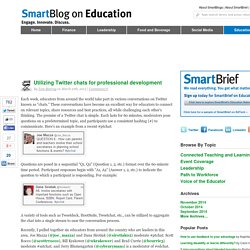
These conversations have become an excellent way for educators to connect on relevant topics, share resources and best practices, all while challenging each other’s thinking. The premise of a Twitter chat is simple. Each lasts for 60 minutes, moderators pose questions on a predetermined topic, and participants use a consistent hashtag (#) to communicate. Here’s an example from a recent #ptchat: Questions are posed in a sequential “Q1, Q2” (Question 1, 2, etc.) format over the 60-minute time period. A variety of tools such as Tweetdeck, HootSuite, Tweetchat, etc., can be utilized to aggregate the chat into a single stream to ease the conversation process. Recently, I pulled together six educators from around the country who are leaders in this area.
Blumengarten (@cybraryman1) has cataloged a list of Twitter chats, which can be found here. Some recommended chats include: